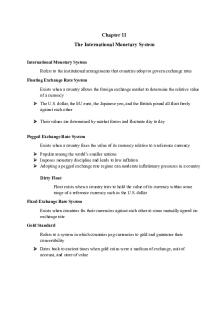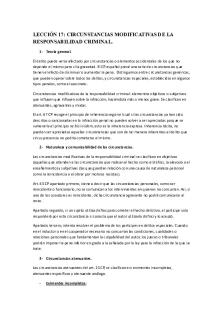Chem 9 15 17 - Lecture notes 11 PDF

| Title | Chem 9 15 17 - Lecture notes 11 |
|---|---|
| Course | General Chemistry I |
| Institution | University of Missouri-Kansas City |
| Pages | 3 |
| File Size | 88.3 KB |
| File Type | |
| Total Downloads | 82 |
| Total Views | 159 |
Summary
Calculating Amounts of Reactions and Products
Dr. Gounev...
Description
Calculating Amounts of REactants and Products Stoichiometric Equivalents ● Balanced chemical equations contain definite stoichiometric relations between reactants and products → stoichiometric mole ratios ● Example: ○ 2H2 + O2 → 2H2O ○ 2 mol H2 → 1 mol O2 ○ 2 mol H2 → 2 mol H2O ○ 1 mol O2 → 2 mol H2O ○ 1 mol O2 / 2 mol H2 ○ 2 mol H2O / 2 mol H2 ● Mole to mole conversions ○ Conversion method ○ The mole ratios are used as conversion factors ○ (mol given)X(mole ratio)=(mol required) ○ Example: ■ Determine the number of moles of water produced from 3.4 mol O2 ■ Balanced equation: 2H2 +O2 → 2H2O ■ Mole ratio (conversion factor) : [2 mol H2O/1mol O2] ■ 3.4 mol O2 X ( 2mol H2O / 1 mol O2) = 6.8 mol ○ Stoichiometric conversion factors are reaction specific ○ Example: ■ Calculate the amount of O2 needed to produce 3.5 mol H2O by combustion of methane (CH4) ● Balanced equation= CH4+2O2 → CO2 +2H2O ● Mole ratio ○ 2 mol O2 → 2 mol H2O ● 3.5 mol H2O X ( 2 mol O2 / 2 mol H2O) = 3.5 mol O2 Mass to mass calculations: ● Example: ○ Calculate the mass of oxygen needed to completely burn 5.4 kg of Butane (C4H10) ■ 2C4H10 +13O2 → 8CO2 +10H2O ■ Mole ratio ● 13 mol O2 per 2 mol C4H10 ■ Molar masses ● C4H10 → 58.1 g/mol ● O2 → 32.0 g/mol ■ 5.4kcC4H10 X (10^3 g C4H10 / 1 kg C4H10) X ( 1 mol C4H10 / 58.1 g C4H10) X (13 mol O2 / 2 mol C4H10) X (32.0 g O2 / 1 mol O2) = 1.9x10^4 g O2= 19 kg O2 Reaction Yield ● Theoretical yield- the maximum amount of product that can be expected to form a
given amount of reactant Actual yield- the actual amount of product isolated in a reaction ○ Actual yield < theoretical yield ○ Reasons for the difference between actual and theoretical yield ■ Incomplete reaction ■ Loss of products ● Some product can dissolve in solvent ● Some product stuck on walls ■ Side reactions ● Percentage yield- actual yield divided by theoretical yield times 100% ● Example: ○ Calculate the theoretical yield of carbon dioxide produced by the combustion of 25.og of propane (C2H8) in excess O ■ C3H8 +5O2 → 3CO2 + 4H2O ■ Mass to mass conversion ● 25.0 g C3H8 X ( 1 mol C3H8 / 44.09 g C3H8) X ( 3 mol CO2 / 1 mol C3H8) X (44.01 g CO2 / 1 mol CO2) = 74.9 g CO2 → theoretical yield ● Example (Percent Yield): ○ Calculate the percentage yield of carbon dioxide if the combustion of 25.0 g propane in excess oxygen yields 48.5 g carbon dioxide ■ 48.5 g CO2 actually yields this much ■ Theoretical yield (from previous example) 74.9 g CO2 ■ Side reaction ( consumes some of the propane) ● 2C3H8 + 7O2 → 6CO + 8H2O ■ 48.5g CO2 / 74.9 g CO2 X 100% = 63.8% Limiting Reactants: ● Reactants present in equivalent amounts ○ All reactants are consumed at the same time ● Non Equivalent amounts of reactants ○ One reactant, called limiting reactant, is consumed before the others ○ The other reactants are in excess ● Limiting reactant ○ The reaction stops when the limiting reactant is consumed ○ Limits the maximum amount of product achievable (limits theoretical yield) ○ Stoichiometric calculations based on the limiting reactant give the lowest amount of product compared to calculations based on the other reactants ● Example: ○ Identify the limiting reactant in the reaction of 5.0 mol H2 with 3.0 mol N2 and determine the theoretical yield of NH3 in this reaction ■ 3H2 + N2 → 2NH3 ■ Take the theoretical yield of each reactant and take the smallest number as your limiting reactant ■ 3.0 mol N2 ( 2 mol NH3 / 1 mol N2) = 6.0 mol NH3 ●
■ ●
5.0 mol H2 X ( 2 mol NH3 / 3 mol H2) = 3.3 mol NH3 → limiting reactant and theoretical yield
Example: ○ Calculate the theoretical yield of HNO3 in the reaction of 28 g NO2 and 18 g H2O by the chemical equation: ■ 3NO2 + H2O → 2HNO3 + NO ■ Calculate the theoretical yield based on each of the reactants and chose the smaller result ● 18 g H2O X ( 1 mol H2O / 18.0 g H2O) X ( 2 mol HNO3 / 1 mol H2O) X ( 63.0 g HNO3 / 1 mol HNO3) = 130 g HNO3 ● 28 g NO2 X ( 1 mol NO2 / 46.0 g NO2) X ( 2 mol HNO3 / 3 mol NO2) X ( 63.0 g HNO3 / 1 mol HNO3 ) = 26 g HNO3 → theoretical yield...
Similar Free PDFs

Chem 9 15 17 - Lecture notes 11
- 3 Pages

Lectures 11-15 - Lecture notes 12-15
- 11 Pages

Ecology Lecture Notes 9-15
- 2 Pages

Chapter 11 - Lecture notes 9
- 5 Pages

(8) Leases - Lecture notes 15-17
- 10 Pages

Chapter 15 & 17 notes
- 2 Pages

2-9-15 - Lecture notes 4
- 1 Pages

LecciÓn 17 - Lecture notes 17
- 6 Pages

Chapter 17 - Lecture notes 17
- 15 Pages

Episode 9-15 - Lecture notes 1-2
- 25 Pages

Chapter 17 - Lecture notes 17
- 7 Pages

11 - Lecture notes 11
- 14 Pages

Cal eco 9:11 - Lecture notes 6
- 3 Pages
Popular Institutions
- Tinajero National High School - Annex
- Politeknik Caltex Riau
- Yokohama City University
- SGT University
- University of Al-Qadisiyah
- Divine Word College of Vigan
- Techniek College Rotterdam
- Universidade de Santiago
- Universiti Teknologi MARA Cawangan Johor Kampus Pasir Gudang
- Poltekkes Kemenkes Yogyakarta
- Baguio City National High School
- Colegio san marcos
- preparatoria uno
- Centro de Bachillerato Tecnológico Industrial y de Servicios No. 107
- Dalian Maritime University
- Quang Trung Secondary School
- Colegio Tecnológico en Informática
- Corporación Regional de Educación Superior
- Grupo CEDVA
- Dar Al Uloom University
- Centro de Estudios Preuniversitarios de la Universidad Nacional de Ingeniería
- 上智大学
- Aakash International School, Nuna Majara
- San Felipe Neri Catholic School
- Kang Chiao International School - New Taipei City
- Misamis Occidental National High School
- Institución Educativa Escuela Normal Juan Ladrilleros
- Kolehiyo ng Pantukan
- Batanes State College
- Instituto Continental
- Sekolah Menengah Kejuruan Kesehatan Kaltara (Tarakan)
- Colegio de La Inmaculada Concepcion - Cebu


